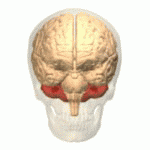
Photo from wikipedia
ABSTRACT Background: Rehabilitation in cerebral palsy (CP) seeks to harness neuroplasticity to improve movement, including walking, yet cortical activation underlying gait is not well understood. Methods: We used electroencephalography (EEG)… Click to show full abstract
ABSTRACT Background: Rehabilitation in cerebral palsy (CP) seeks to harness neuroplasticity to improve movement, including walking, yet cortical activation underlying gait is not well understood. Methods: We used electroencephalography (EEG) to compare motor related cortical activity, measured by mu rhythm, during quiet standing and treadmill walking in 10 children with unilateral CP and 10 age- and sex-matched children with typical development (TD). Peak mu band frequency, mu rhythm desynchronization (MRD), and gait related intra- and inter-hemispheric coherence were examined. Results: MRD during walking was observed bilaterally over motor cortex in both cohorts but peak mu band frequency showing MRD was significantly lower in CP compared to TD. Coherence during quiet standing between motor and frontal regions was significantly higher in the non-dominant compared to dominant hemisphere in CP with no hemispheric differences in TD. Conclusions: EEG-based measures should be further investigated as clinical biomarkers for atypical motor development and to assess rehabilitation effectiveness.
Journal Title: Developmental Neurorehabilitation
Year Published: 2020
Link to full text (if available)
Share on Social Media: Sign Up to like & get
recommendations!